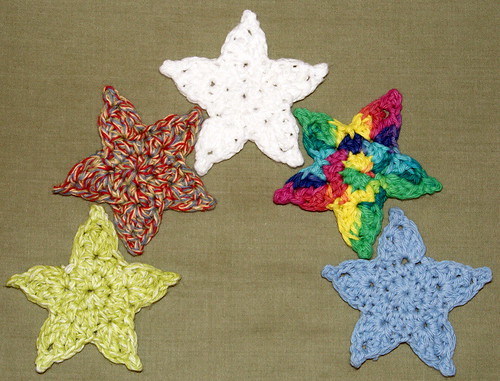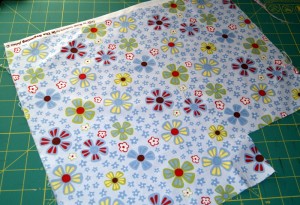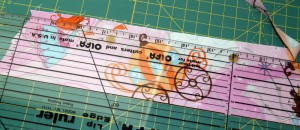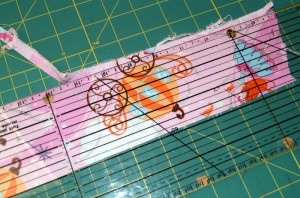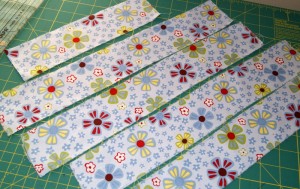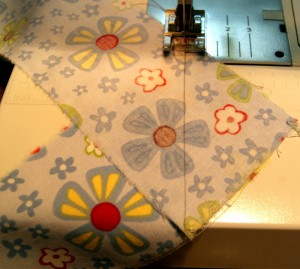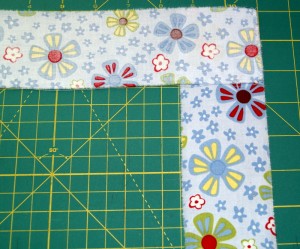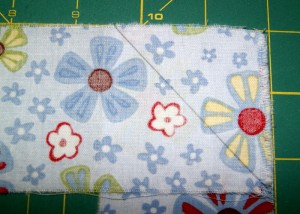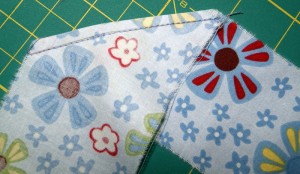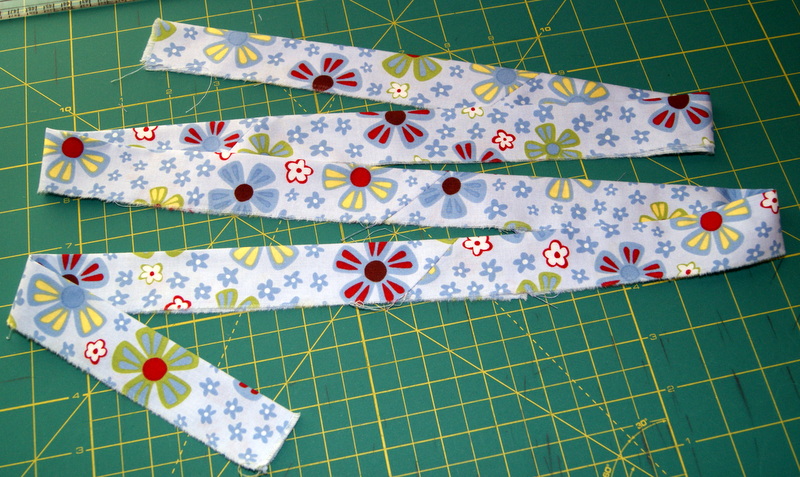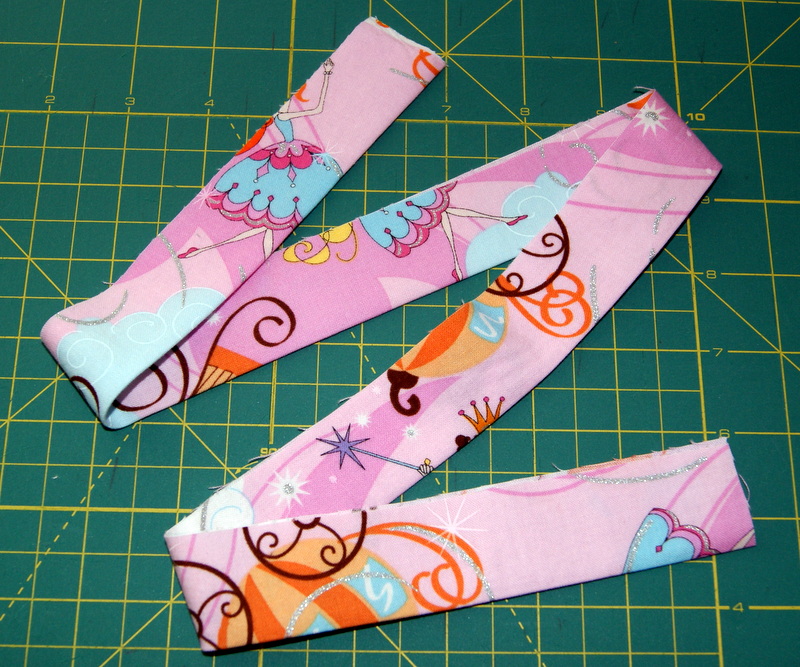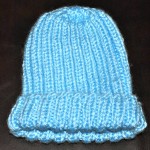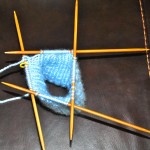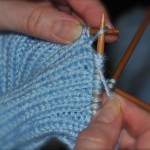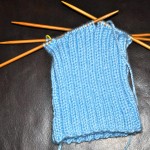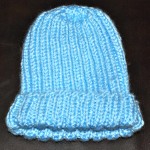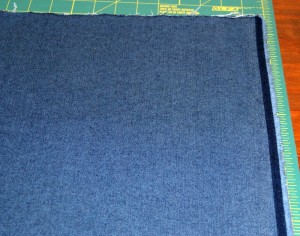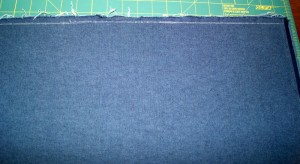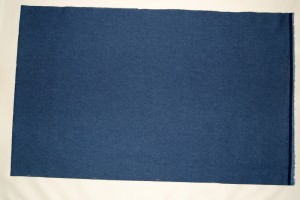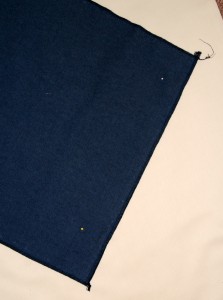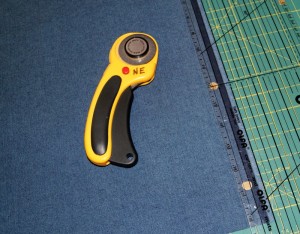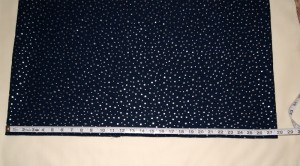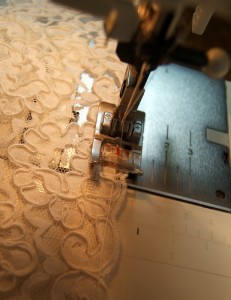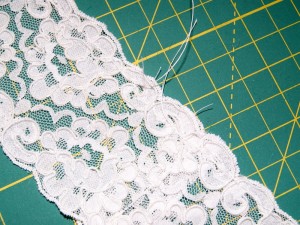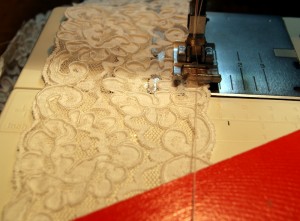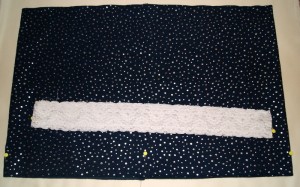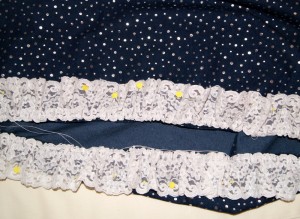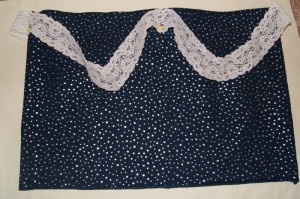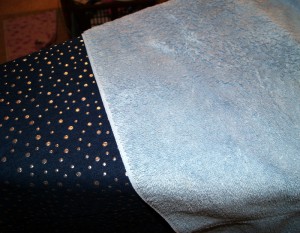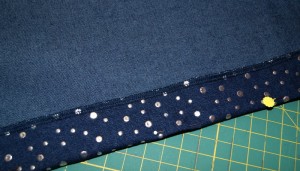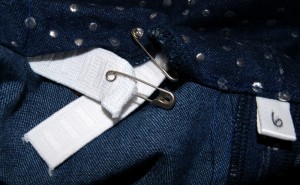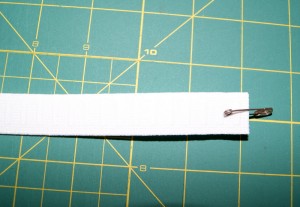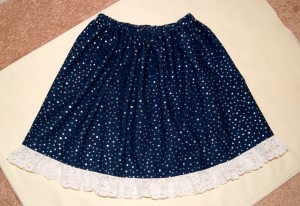Creating Bindings
I like to make bindings from my cotton scraps and have them ready in my stash pile for any current or future sewing projects. They are not hard to make and it is nice to have a one-of-a-kind trim available.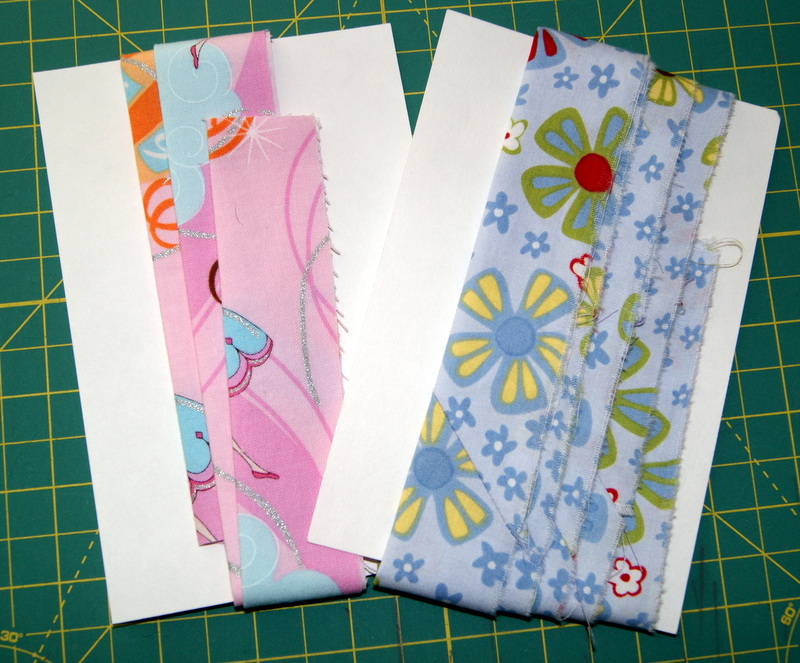 The type of binding that I am demonstrating is using the straight of grain or lengthwise grain on the fabric. Good for almost any type of project except a small circle which you might have puckering but a bias type binding would work for those small tight curves. Cut your strips on the bias (diagonal edge to diagonal edge) and follow these directions to create bias binding.
The type of binding that I am demonstrating is using the straight of grain or lengthwise grain on the fabric. Good for almost any type of project except a small circle which you might have puckering but a bias type binding would work for those small tight curves. Cut your strips on the bias (diagonal edge to diagonal edge) and follow these directions to create bias binding.
Using a 2 1/2″ wide cut fabric strip makes for a very nice binding finished width. What I prefer to do is to rip the cotton fabric on the straight of grain to create my working 2 1/2″ width. If your scrap piece is not wide enough to rip, then just utilize a good ruler and measure for a 2 1/2″ width using a rotary cutter. Your cut length can be whatever size you have remaining from your scrap fabric.
To sew your cut scraps together to form a professional looking seam, you will put right sides together making an upside down “L”. Take a good ruler, using a pencil or soap, make a stitching line to sew along for a perfect join. You will then sew from the top edge to the side edge on your binding strip. Trim your seam close to the stitching line and press seam open.
Once you have all your joins stitched together for your binding, fold the strip with wrong sides together and press.
Now you have binding that is ready to be sewn to whatever project you are working on. When sewing the binding to my project, I always use a 1/4″ seam allowance.
Making binding is an easy scrap project for a child who has experience with a sewing machine. Ripping fabric is a fun thing for a youngster to do. I wouldn’t suggest letting them use a rotary cutter, only an adult should handle that sewing tool!!
I like to wrap my bindings onto index cards so they can be stored flat in a see thru type storage bin. You will find many different uses for bindings from quilts, bibs, hooded towels, placemats, clothing, etc.!!
HAPPY CREATING!!
Disclaimer: This post contains affiliate links – “small commission earned”
Newborn/Preemie Crochet Pattern
Just discovered a fellow crocheter from Ravelry (a wonderful crochet/knit site) who has been busy making my newborn/preemie crochet beanie pattern and donating them to her local hospital. Way to go Loz!!
Check out her website http://xloz68x.wordpress.com/ to see her cute beanies!!
Let me know if anyone else has been making these too!! They really are easy and loads of fun to make and for a wonderful cause.
HAPPY CREATING!!
Disclaimer: This post contains affiliate links – “small commission earned”
Knitted Baby Beanie
I really, REALLY, love to crochet but I did make a New Year’s Resolution to practice my knitting techniques this year too. So here it is May already and I thought I had better try something before the year escapes me.
I’ve been crocheting little newborn beanies for a local hospital that just opened a new maternity ward and thought this would be a great place to begin a knitting project. I looked through my books and magazines for a simple pattern but nothing grabbed me. Finally I found a cute idea on Flickr for a stretchy ribbed newborn pattern, done in the round!! What really made me decide that this was the pattern for me was the fact that it will stretch easily to fit many different sized heads!! I want to thank Shandeh for sharing her pattern on Flickr. I made one change and that was that I cast on 76 stitches rather than her recommended 68 using 8″ dpns, size US #6 (4.00mm). I think I knit a little tight and felt the extra stitches gave my hat a better size.
This was my first attempt at knitting with Double Pointed Needles (DPNs). Actually had to look up that abbreviation, told you I was really a crochet fanatic!! Also, I knitted my beanie using 4 dpns because I was having issues with laddering (another new knitting term for me). But wasn’t going to let that stop me!! I was a little like Edward Scissorhands in the beginning but got my rhythm going quickly. Found that if I made sure the two dpns that I was knitting from were on top of the two needles that were just holding my stitches, it was much easier to knit the ribbing pattern.
The entire pattern is just a knit 2, purl 2 ribbing that you do for a total of 6 inches. Then you start decreasing. First decrease round is knit2tog, purl2tog, leaving 38 stitches. Then knit a round. Next decrease round is knit2tog, leaving 19 stitches on your needles. Complete another knit round. Third decrease round knit2tog, with 10 stitches remaining on your needles (including the one stitch left over). Cut your yarn leaving about 8″ tail, attach your darning needle and weave your needle through the last 10 stitches and pull tight. Push darning needle to the wrong side of your beanie and weave in the loose end. Now your beanie is ready to be donated or for your new arrival!!
I really like the finished look of this little beanie and I am now working on enlarging the pattern because this would be a great beanie for toddlers too!!
HAPPY CREATING!!
Disclaimer: This post contains affiliate links – “small commission earned”
,
Sewing a Child’s Gathered Skirt with Lace Ruffle
This is an update to my free child’s gathered skirt pattern. I have included lots of 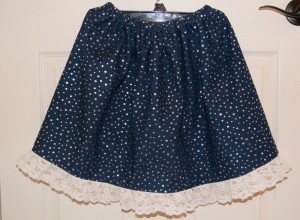 pictures and my sample shows how to attach a lace ruffle to the bottom edge of my denim skirt. The lace I am working with has a finished edge on both sides, no hemming necessary.
pictures and my sample shows how to attach a lace ruffle to the bottom edge of my denim skirt. The lace I am working with has a finished edge on both sides, no hemming necessary.
On my pattern page, you will find directions on how to determine your cut width and cut length. STEP 1: Be sure to match up the selvage edges together and place that edge along a straight ruler line so that your top and bottom cuts will be even.
If using a 100% cotton fabric, you can make a small cut along the top and bottom edges and just rip your fabric to get that nice straight of grain edge to work with.
STEP 2: Once you have your fabric cut, I like to serge all the fabric edges. I cut off the selvages with my straight ruler before I do the serging. If you don’t have a serger, you can always do a close zigzag stitch along the raw edges.
STEP 3: With right sides together, sew a 1/2″ seam allowance. Press your seam open. STEP 4: Lay out your skirt and measure from side seam to side seam. You will want to double that measurement so you have the total circumference of your skirt. Take that measurement and multiple it by 1.5 up to 2 times to determine how long to cut your lace.
STEP 5: Cut your lace to the pre-determined measurement and sew it together with right sides matching. Make a gathering seam by sewing a loose zigzag stitch over top of a heavy-duty (dual duty) thread on the wrong side of the lace. This makes for a very strong gathering thread that you can pull on very tightly and it will not break.
STEP 6: Divide your skirt into fourths, placing a pin at the center back seam, center front seam and both sides. You will also fold your lace into fourths and place pins at each fold. Now with right sides together, pin your lace markings to the skirt markings. Pull snuggly on one heavy duty gathering thread and pin your gathers from center back to center front on one side. Now repeat that step for the other side, pulling snuggly using the other heavy duty gathering thread to gather up the lace and pin to the skirt. Stitch in place.
STEP 7: You want to press that seam up towards the top of the skirt. Because my denim had painted silver dots on it and the lace was somewhat delicate, I used a terry cloth towel as my pressing cloth so as not to have any damage (melted dots or lace)!! STEP 8: After the seam is pressed up, stitch that seam in place. I made two (2) rows of stitching because I like that look. One row of stitching is sufficient.
STEP 9: Make the casing for the elastic by folding down the top edge of the skirt 1 1/2″. Pin in place at the folded edge and turn under the serged edge as you stitch leaving about a 2″ opening to pull your elastic through. Attach a safety-pin to one end of your 3/4″ non-roll elastic and begin pulling it through the casing. So I wouldn’t pull the end of the elastic into my casing, I pinned it to the opening. Once you have pulled the elastic through the entire casing, over lap it about 1/2″ on each side and stitch securely into place. Make sure you haven’t twisted the elastic before sewing. After stitched, pull on the waist band so the elastic is nicely tucked inside and stitch close your opening.
STEP 10: To help keep your gathers in place, make a stitching line at the center back, center front, and both sides. Stitch from the top of the waist band to the stitching line of the casing (sewing through all thicknesses).
HAPPY CREATING!!
Disclaimer: This post contains affiliate links – “small commission earned”
